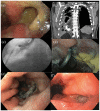Endoscopic management of anastomotic leak after esophageal or gastric resection for malignancy: a multicenter experience
- PMID: 35154387
- PMCID: PMC8832292
- DOI: 10.1177/17562848211032823
Endoscopic management of anastomotic leak after esophageal or gastric resection for malignancy: a multicenter experience
Abstract
Background: Most anastomotic leaks after surgical resection for esophageal or esophagogastric junction malignancies are treated endoscopically with esophageal stents. Internal drainage by double pigtail stents has been used for the endoscopic management of leaks following bariatric surgery, and recently introduced for anastomotic leaks after resections for malignancies. Our aim was to assess the overall efficacy of the endoscopic treatment for anastomotic leaks after esophageal or gastric resection for malignancies.
Methods: We conducted a multicenter retrospective study in four digestive endoscopy tertiary referral centers in France. We included consecutive patients managed endoscopically for anastomotic leak following esophagectomy or gastrectomy for malignancies between January 2016 and December 2018. The primary outcome was the efficacy of the endoscopic management on leak closure.
Results: Sixty-eight patients were included, among which 46 men and 22 women, with a mean ± SD age of 61 ± 11 years. Forty-four percent had an Ivor Lewis procedure, 16% a tri-incisional esophagectomy, and 40% a total gastrectomy. The median time between surgery and the diagnosis of leak was 9 (6-13) days. Endoscopic treatment was successful in 90% of the patients. The efficacy of internal drainage and esophageal stents was 95% and 77%, respectively (p = 0.06). The mortality rate was 3%. The only predictive factor of successful endoscopic treatment was the initial use of internal drainage (p = 0.002).
Conclusion: Endoscopic management of early postoperative leak is successful in 90% of patients, preventing highly morbid surgical revisions. Internal endoscopic drainage should be considered as the first-line endoscopic treatment of anastomotic fistulas whenever technically feasible.
Keywords: anastomotic leak; double pigtail stent; endoscopic management; esophageal cancer; esophageal or gastric cancer; esophagogastric junction adenocarcinoma; gastric cancer; internal drainage; self-expendable metallic stent.
© The Author(s), 2021.
Conflict of interest statement
Conflict of interest statement: The authors declare that there is no conflict of interest.
Figures


References
-
- Pimentel-Nunes P, Dinis-Ribeiro M, Ponchon T, et al.. Endoscopic submucosal dissection: European Society of Gastrointestinal Endoscopy (ESGE) guideline. Endoscopy 2015; 47: 829–854. - PubMed
-
- Wu PC, Posner MC. The role of surgery in the management of oesophageal cancer. Lancet Oncol 2003; 4: 481–488. - PubMed
-
- Degisors S, Pasquer A, Renaud F, et al..; FREGAT Working Group. Are thoracotomy and/or intrathoracic anastomosis still predictors of postoperative mortality after esophageal cancer surgery?: a nationwide study. Ann Surg 2017; 266: 854–862. - PubMed
LinkOut - more resources
Full Text Sources

